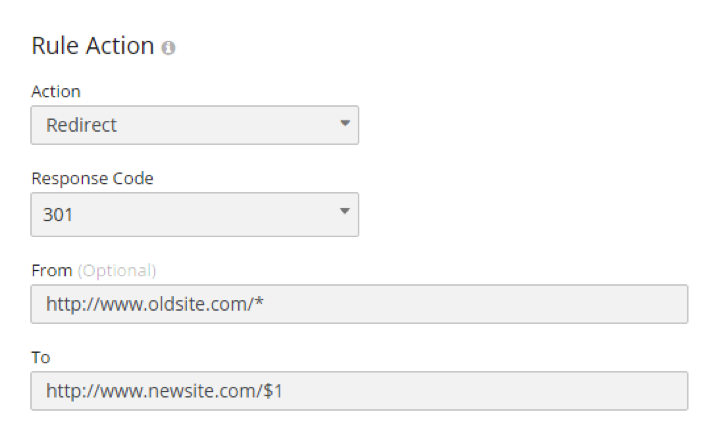Available with Incapsula Load Balancer, application delivery rules let enterprises improve application performance and availability. Rules can be used to modify request or response headers, route traffic to different origins or URLs, or determine whether a response should be returned directly from the cache. Let us share with you some common application delivery use cases you can use to modernize your website.
Redirects
One example of using an application delivery rule is to permanently redirect users to a new site or URL. For example, you need to redirect your website visitors need to a new URL when old websites or pages have been retired. When a request matches a condition of a redirect rule, Incapsula responds with a W3C 30x response code and appropriately redirects the client. The redirected URL can be fixed for all requests matching the rule condition or can be customized using wildcards based on each specific request line as shown in the screenshot below. For more details on redirect configuration specifics, see this page.

Here’s another example of how you can use the redirect feature. Say you own an e-commerce site. Your competitor is scraping your prices and using that information to undercut you on price comparison websites. Incapsula helps you identify the scraper, and then use application delivery rules to redirect its requests to a special site or server that serves bogus pricing.
Forwards
In another scenario, you may want to configure content switching for specific resources. When certain resources are located on a dedicated server such as graphics stored on an image server, all requests for these resources can be forwarded to that device. The screenshot below shows a common example for a rule that forwards all requests for jpg resources to a specific origin server.
Click here to see details on how to configure a forward request with Incapsula.

Rewriting URLs
Complex URLs are useful for querying an internal database but have little meaning for end users. Use application delivery rules to rewrite your customer-facing URLs in a way that it not only improves user experience, but also helps increase your SEO rankings. A Rewrite URL rule can be used in this case.
In the example below we do three things:
- Distinguish between US and non-US end users so the latter group will get the soccer page when accessing the football page
- Simplify the URL structure by changing it from /sports/football/soccer to /football
- Use wildcards to indicate all sub pages to reduce the number of rules and improve rules management

How Application Delivery Rules Improves Security and Performance
Built-in technology in application delivery rules improves security for your site and user experience by providing the following:
- Behavioral Analysis – Application delivery rules can be defined based on end user behavior. Incapsula measures request rates in real-time when making routing decisions, while offering default rate thresholds for various parameters. For example, if the rate of POST requests to a URL from a specific IP address over a one-minute period exceeds a predefined threshold, the requests can be blocked or redirected to a temporary page.
- Bot mitigation and manipulation – Created to detect and block malicious bots used in distributed denial of service (DDoS) attacks, scraping and vulnerability scanning, Incapsula proprietary traffic inspection and client classification technology is also used to build sophisticated application delivery rules. Our security expertise and bot detection experience allows us to distinguish between humans, good bots and bad bots, and then deal with all traffic accordingly.
- Easy, Centralized Rule Management– Incapsula application delivery rules are conceptually similar to our IncapRules engine used to create custom security rules. An intuitive rule builder lets non-technical users define and generate centralized application delivery rules for all origin servers. Both security and application delivery rules use the same syntax and reside in a single central repository.
- Minimal Latency – An Incapsula online shopper survey shows that 62 percent of e-commerce site visitors will only wait up to five seconds (or less) for a page to load before clicking away. Time is always of the essence. By leveraging our global CDN, application delivery rules that run at the network edge brings your site closer to your users. For example, if your data center is in New York and an end user resides in Japan, rules are applied in our Tokyo data center—less than 10 milliseconds away from users located there.
- Managed Change and Version Control– Rule versions and revisions have tracing and rollback capability to support change management processes. Your website administrators can review a rule change audit and easily revert to a previous rule revision if needed.
- Consolidated Reporting– Similar to our security features, you can monitor application delivery rules through the Incapsula dashboard and our SIEM integration. Summary and detailed reports are available for all actions and events across all of your application servers. The dashboard displays statistics on the most used rules, providing you with better visibility into your application traffic.
- Redundancy and Scalability– Regardless of the number of application delivery rules you use, with Incapsula you never have to worry about upgrading your hardware, software or other deployment issues. With 32 data centers located in strategic global locations, redundancy and scalability are built into our cloud-based service.
See firsthand how easy it is to configure application delivery rules by reviewing our online guide. Have any comments or questions about application delivery rules? Please leave me a comment.
Try Imperva for Free
Protect your business for 30 days on Imperva.













